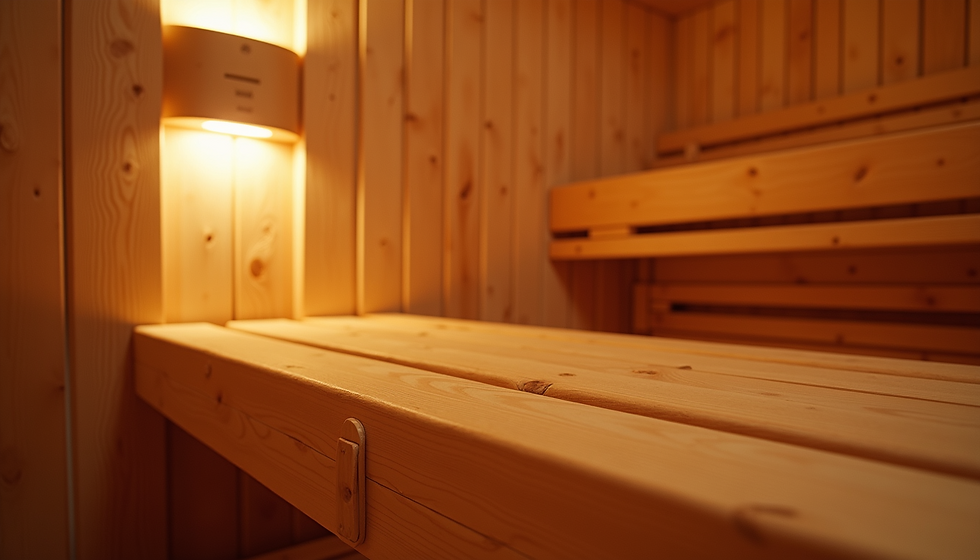Effective Ways to Support Your Body's Healing Process
- Patrick Frank

- 5 days ago
- 5 min read
When your body is healing—whether from injury, illness, or surgery—it needs extra care. Supporting recovery can speed healing, reduce discomfort, and improve your overall well-being. This guide covers simple, natural ways to help your body recover more efficiently, plus how tools like San Diego infrared sauna, sauna with cold plunge, and cold plunge therapy can fit into your routine.
Understanding Body Recovery: What It Means and Why It Matters
Body recovery is the process your body uses to repair damaged tissues, restore function, and regain strength. It involves inflammation calming down, cells regenerating, and your immune system doing repair work.
How well you support this process can influence how quickly and comfortably you heal.
Key factors that influence body recovery include:
Nutrition: Fuels tissue repair and immune function.
Rest: Gives your body time to heal without strain.
Hydration: Maintains fluid balance for cellular repair.
Stress management: Lowers stress hormones that can slow healing.
Some people also layer in recovery tools like infrared sauna and cold plunge, wellness sauna, cold plunge and cryotherapy, or saunas San Diego studios to boost circulation, reduce soreness, and deepen relaxation.

Practical Tips to Enhance Your Body Recovery
Supporting your body’s healing process is about daily choices. Here are actionable ways to help your system repair and reset.
1. Prioritize Balanced Nutrition
Food is one of the most powerful recovery tools.
Protein helps rebuild tissue, while vitamins like C and A support immune function and skin repair.
Add lean meats, fish, eggs, and plant-based proteins.
Load up on colorful fruits and vegetables for antioxidants.
Limit processed foods and sugar, which can drive inflammation.
If you use San Diego infrared sauna, sauna plunge, or cold plunge studios as part of your recovery, a nutrient-rich diet helps your body bounce back from heat and cold immersion sessions and maximizes the benefits of contrast therapy.
2. Stay Hydrated
Water helps transport nutrients, remove waste, and keep cells functioning well.
Aim for at least 8 glasses a day, more if you’re active, sweating in a San Diego sauna, or doing steam room then cold plunge or hot and cold plunge circuits.
3. Get Adequate Rest and Sleep
Sleep is prime repair time. During deep sleep, your body releases hormones that help rebuild tissue and regulate inflammation.
Aim for 7–9 hours of quality sleep each night. Create a calming pre-bed routine and reduce screen time. A relaxing evening session at a spa with cold plunge, bathhouse San Diego, or bathhouses in San Diego can help you unwind and fall asleep easier.
4. Manage Stress Effectively
Chronic stress raises cortisol, which can slow healing and increase inflammation.
Use tools like deep breathing, meditation, and gentle stretching to calm your nervous system. Many people ask, how does visualization promote relaxation and stress reduction? Visualization lets you mentally rehearse calm, safe scenes—your body responds by relaxing, which supports immune function and recovery.
Even a few minutes of mindfulness a day can make a difference, especially when paired with restorative spaces like San Diego bath house style spas or quiet recovery areas.
5. Engage in Gentle Movement
Total rest can lead to stiffness and slower circulation. Gentle movement keeps blood flowing without overloading healing tissues.
Try:
Short walks
Light stretching
Gentle yoga or mobility work
If you’re already training in a gym with sauna San Diego athletes love or at gyms with ice bath, use off-days for low-intensity movement and light recovery—like a short sauna with cold plunge session followed by stretching.
6. Consider Professional Support
Sometimes, extra support accelerates healing.
Options include:
Physical therapy for targeted rehab
Massage therapy to reduce tension and improve circulation
Acupuncture to support pain relief and balance
Holistic recovery programs may also combine therapies like San Diego cryotherapy, cryotherapy la jolla, cryotherapy chula vista, or a cryo recovery lounge with infrared heat and contrast tools like cold plunge therapy lounge for a full-body reset.
If you’re curious about hot–cold routines, it’s common to ask when to sauna and cold plunge, should you do sauna or cold plunge first, or should you do cold plunge or sauna first. Most people start with heat, then move briefly into cold, always listening to their body and any medical guidance.

What are the 5 Stages of Recovery?
Understanding the stages of recovery can help you set realistic expectations and notice progress, even when it feels slow.
1. Hemostasis
This is the immediate response after injury. Your body forms a clot to stop bleeding and protect the area.
2. Inflammation
Next, your immune system sends cells to the site to fight infection and clear damaged tissue. This phase can bring redness, swelling, warmth, and pain—it’s a normal part of healing.
3. Proliferation
New tissue forms during this phase. Cells multiply, and new blood vessels develop to nourish the healing area.
4. Maturation
Also called remodeling, this stage strengthens the new tissue and restores function. It can last weeks to months depending on the injury.
5. Resolution
In this final stage, inflammation settles and the area functions more like normal again.
You may still need to support the tissue with strength work, stretching, and ongoing recovery habits—things like a consistent sauna membership, occasional sessions at cold plunge carlsbad or cold plunge therapy near you, or visits to studios like breathe degrees san diego, all my cryo, wood therapy san diego, the sauna lab / sauna lab, or cryospa near your location.

Additional Lifestyle Habits to Support Healing
Beyond the basics, several lifestyle habits can further enhance your body’s recovery:
Avoid smoking and limit alcohol: Both can impair immune function and delay healing.
Maintain a healthy weight: Excess weight can strain healing tissues.
Protect the injured area: Use supports or braces as recommended to prevent re-injury.
Stay consistent with medications: Follow your doctor’s instructions for any prescribed treatments.
Incorporating these habits into your daily routine can create a strong foundation for recovery.
Embracing a Holistic Approach to Healing
Healing is not just physical; emotional and mental well-being play a crucial role. Practices such as journaling, connecting with supportive people, and engaging in hobbies can reduce stress and improve your outlook.
Remember, recovery is a journey. Celebrate small milestones and be patient with your body as it works to restore itself.
By combining proper nutrition, rest, gentle activity, stress management, and professional support, you can effectively support your body’s healing process and return to your best self.
Supporting your body’s recovery is a vital investment in your health. With the right care and attention, you can enhance healing, reduce complications, and regain strength more quickly. Start implementing these strategies today to give your body the best chance to heal naturally and fully.




Comments